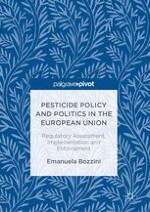2017 | OriginalPaper | Chapter
4. Open Controversies: Bees’ Health, Glyphosate and Endocrine Disruption
Author : Emanuela Bozzini
Published in: Pesticide Policy and Politics in the European Union
Publisher: Springer International Publishing
Activate our intelligent search to find suitable subject content or patents.
Select sections of text to find matching patents with Artificial Intelligence. powered by
Select sections of text to find additional relevant content using AI-assisted search. powered by
